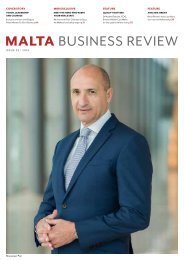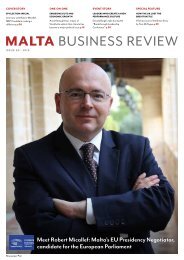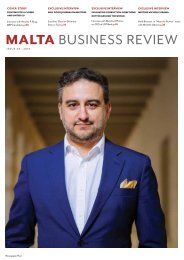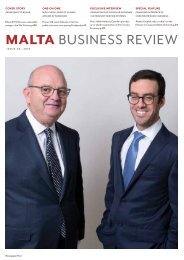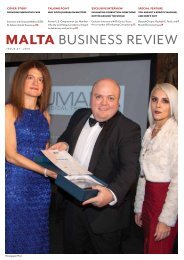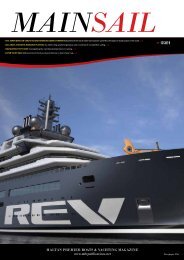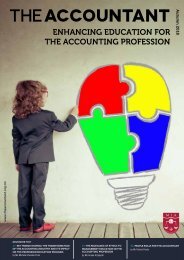ACCOUNTANT_SUMMER18_AMENDED_PG12
Create successful ePaper yourself
Turn your PDF publications into a flip-book with our unique Google optimized e-Paper software.
DATA ANALYTICS<br />
USING DATA ANALYTICS FOR AUDIT EVIDENCE<br />
T<br />
echnology is shaping<br />
and changing our lives.<br />
Answering machines<br />
are long gone as people feel<br />
the need to be connected at<br />
all times. Information needs to<br />
be on tap as even looking up<br />
a book takes too long. Some<br />
employees who traditionally<br />
worked from their desk at the<br />
office, now work remotely<br />
from home or even from<br />
a different country, as staff<br />
mobility is not even about<br />
relocation anymore.<br />
The audit profession is also re-inventing itself but<br />
maybe not at the pace we’d like to believe. Whereas<br />
auditing has been around in one form or other, for<br />
around 3,000 years, Mautz and Sharaf started to give<br />
shape to the theory of auditing in 1961 with their<br />
publication of The Philosophy of Auditing. Since then,<br />
we have seen a significant increase in guidance on<br />
how to conduct an audit as standards were issued<br />
by bodies such as the International Auditing and<br />
Assurance Standards Board (IAASB) and the American<br />
Institute of CPAs (AICPA). However, questions<br />
continue to be raised by the public as to whether<br />
such the bodies are doing enough to ensure that the<br />
profession keeps with the pace of technology.<br />
In considering whether International Standards on<br />
Auditing (ISAs) are outdated given that they were<br />
drafted before the availability of data analytics<br />
techniques, during September 2016, the IAASB’s<br />
Data Analytics Working Group (DAWG) felt the<br />
need to issue a call for comments through its paper<br />
entitled Exploring the Growing Use of Technology in<br />
the Audit, with a Focus on Data Analytics. The general<br />
consensus was that ISAs were not ‘broken or a barrier<br />
to the application of data analytics in the audit’.<br />
IAASB’s DAWG defines data analytics largely on the<br />
definition used in an AICPA publication entitled Audit<br />
Analytics and Continuous Audit - Looking Toward<br />
the Future. The DAWG states that The quality of a<br />
financial statement audit can be enhanced by the use<br />
of data analytics. Data analytics, when used to obtain<br />
audit evidence in a financial statement audit, is the<br />
science and art of discovering and analyzing patterns,<br />
deviations and inconsistencies, and extracting other<br />
useful information in the data underlying or related<br />
to the subject matter of an audit through analysis,<br />
modelling and visualization for the purpose of<br />
planning or performing the audit.<br />
The use of Audit Data Analytics (ADAs) is thus seen as<br />
an enhancement to and not as a replacement of audit<br />
evidence. It can assist during the entire audit workflow.<br />
In the risk assessment process, ADAs can be used<br />
to provide better insight and support to the auditor<br />
in identifying and assessing the risks of material<br />
misstatement in terms of ISA 315 Identifying and<br />
Assessing the Risks of Material Misstatement through<br />
Understanding the Entity and Its Environment. Such<br />
ADAs may constitute preliminary general ledger<br />
account transaction analysis, correlation of revenue<br />
against industry expectations and analysis of betting<br />
behaviours in an Internet Gaming (iGaming) company.<br />
In testing controls, an entire year’s financial<br />
information may be used in order to:<br />
• evaluate whether segregation of duties policies are<br />
being followed by checking whether transactions<br />
are authorised by an appropriate employee;<br />
CHRISTOPHER AZZOPARDI<br />
CHRISTOPHER AZZOPARDI IS<br />
HEAD OF INFORMATION RISK<br />
MANAGEMENT AT KPMG. HIS<br />
SPECIALISATION LIES IN AUDITING<br />
IT SYSTEMS IN SUPPORTING<br />
FINANCIAL STATEMENTS AUDITS.<br />
HE IS ALSO A MEMBER OF THE<br />
MIA DIGITALISATION COMMITTEE.<br />
theaccountant.org.mt<br />
29






